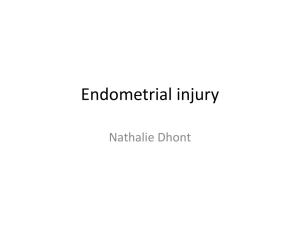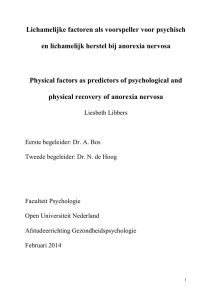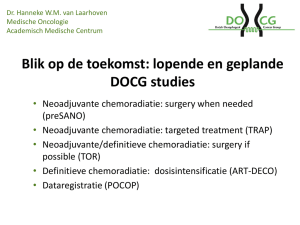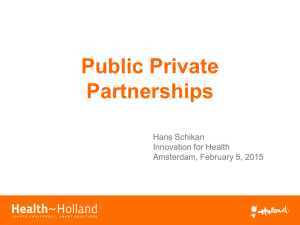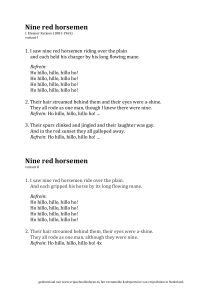Abstractboek - Nederlandse Vereniging voor Anesthesiologie
advertisement
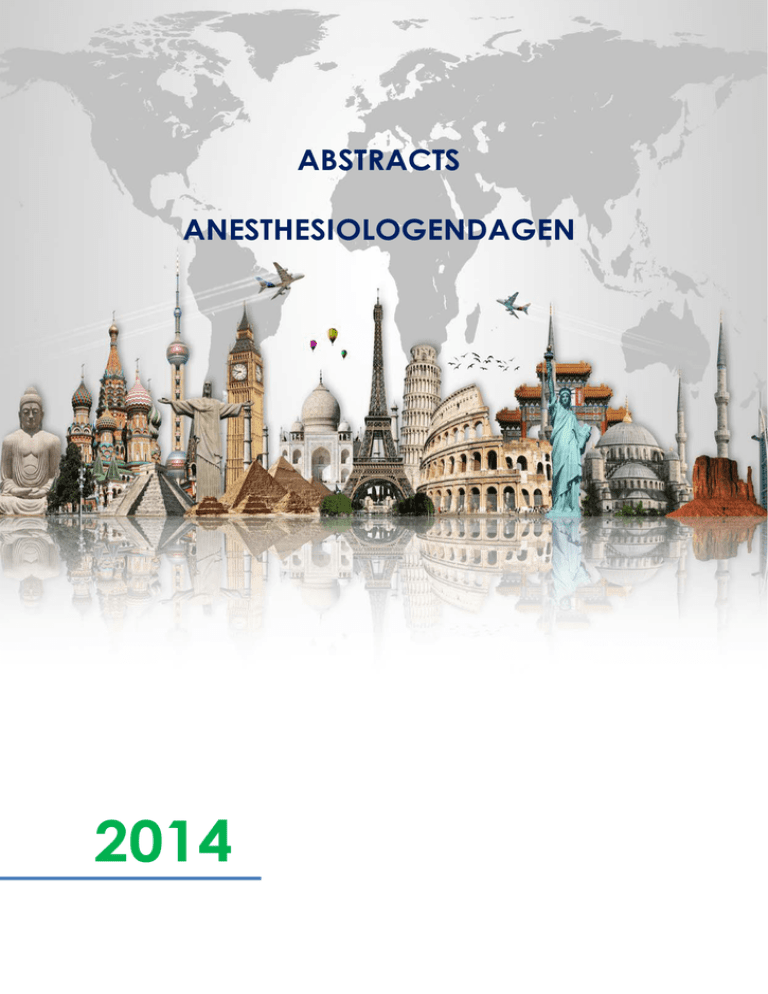
ABSTRACTS
ANESTHESIOLOGENDAGEN
2014
O1
The impact of perioperative red blood cell transfusions on postoperative outcomes in vascular surgery patients
N.T. van der Ploeg1, T.M. Valentijn2, S.E. Hoeks1, F. van Lier1, R.J. Stolker1
1Erasmus
MC, Rotterdam
2Wilhelmina
Ziekenhuis, Assen
Objectives
Red blood cell transfusions are common in vascular surgery and aim to reduce tissue ischemia. However, the
evidence that transfusions are beneficial is contradictory. This study evaluates the impact of perioperative
transfusion (transfusion within 3 days of surgery) on 30-day postoperative outcomes in elective vascular surgery
patients.
Materials and Methods
This observational cohort included 1041 vascular surgery patients for whom hemoglobin levels where retrospectively
available. Patients who received transfusions after 3 days postoperatively were excluded. A propensity score was
developed for the likelihood of receiving perioperative transfusions. The study endpoints were 30-day cardiovascular
events (myocardial infarction, heart failure, arrhythmias, stroke, asymptomatic troponin-T release and cardiovascular
death) and all-cause mortality. Multivariable logistic regression analyses, adjusting for relevant confounders and
transfusion propensity, were used to determine the associations between perioperative transfusion and study
endpoints.
Results
The final study sample comprised 992 patients; 265 (27%) patients received perioperative transfusions.
Perioperative transfusion was associated with an independently increased risk of 30-day cardiovascular events
(Odds Ratio 5.0; 95% Confidence Interval 3.1-8.2) and all-cause mortality (Odds Ratio 4.4; 95% Confidence Interval
1.6-12.1).
Conclusions
Perioperative transfusion is associated with a strongly increased risk of both 30-day cardiovascular events and
mortality in elective vascular surgery patients.
O2
Lidocaine increases the anti-inflammatory cytokine IL-10 following mechanical ventilation in healthy mice.
S.E.I. van der Wal, M. Vaneker, M. Steegers, B.F.M. van Berkum, M. Kox, J. van der Laak, J. van der Hoeven,
K. Vissers, G.J. Scheffer
Radboud UMC, Nijmegen
Aim
Mechanical ventilation (MV) induces an inflammatory response that may result in (acute) lung injury. Lidocaine, an
amide local anesthetic, has anti-inflammatory properties in vitro and in vivo, possibly due to an attenuation of proinflammatory cytokines, ICAM-1 and reduction of neutrophils influx. We am to investigate the role of intravenously
administered lidocaine on MV-induced inflammation in mice.
Methods
Lidocaine (Lido) (2, 4 and 8 mg/kg/h) was intravenously administered during four hours of mechanical ventilation
(MV) with a tidal volume of 8ml/kg, positive end expiratory pressure 1,5 cmH2O and FiO2 0.4. We used one
ventilated control (CON) group receiving vehicle. After MV, mice were euthanized and lungs and blood were
immediately harvested and cytokine levels and ICAM-1 levels were measured in plasma and lung homogenates.
Pulmonary neutrophils influx was determined in LEDER stained slices of lungs. Anesthetic need was determined by
painful hind paw stimulation.
Results
Lidocaine treated animals (Lido 2, 4 and 8) showed higher IL-10 plasma levels compared to control animals (CON).
Lidocaine treatment with 8 mg/kg/h (Lido 8) resulted in higher IL-10 in lung homogenates. No differences were
observed in pro-inflammatory cytokines, ICAM-1 and pulmonary influx between the different ventilated groups.
Conclusions
Intravenously administered lidocaine increases levels of plasma IL-10 with infusion from 2, 4 and 8 mg/kg/h and
pulmonary levels of IL-10 with 8 mg/kg/h, in a murine mechanical ventilation model. Intravenously administered
lidocaine reduces anesthetic need in mice.
O3
Cerebral Autoregulation: When the Head is Positioned above the Heart
E.L. Zeeman1, J.J. van Lieshout2, L.P.H.J. Aarts1, R.V. Immink4
1LUMC,
2AMC,
4UMC
Leiden
Amsterdam
Utrecht, Utrecht
Objectives
When assuming the upright position, mean arterial blood pressure at brain level (MABPbrain) and systemic blood flow
(stroke volume, SV) decrease, with a concurrent decline in cerebral perfusion. Whether decrease in flow, pressure
or both, contribute to lowering in perfusion, remains unraveled. In supine subjects, we applied lower body negative
pressure (LBNP) in a sealed compression box connected to a vacuum source. By causing a reduced cardiac
preload, this box evokes a hemodynamic status similar to head-up tilt (HUT), but without gravitational decrease in
cerebral perfusion pressure. A reduction of 20% SV was accomplished at -30mmHg LBNP and, in tilted subjects, at
50°. We related the steady-state change in cerebral flow to the steady-state change in MABPbrain (=static cerebral
autoregulation) and we quantified the ability of the brain blood flow to counter-regulate a sudden change in
MABPbrain (=dynamic cerebral autoregulation).
Methods
In 10 healthy awake subjects we monitored non-invasive beat-to-beat blood pressure (Nexfin), systemic
hemodynamics (Modelflow) and middle cerebral artery flow velocity (MCAV) by transcranial Doppler. Dynamic
cerebral autoregulation was expressed as the 0.1 Hz MCAVmean-to-MABPbrain phase lead assessed by spectral
analysis.
Results
Tilting from supine to 50° HUT, MABPbrain declined from 73±4 to 58±.5 mmHg and MCAVmean decreased from 68±5
to 63±2 cms-1 (both p<0.05; mean±S.E.M). During -30 mmHg LBNP, MABPbrain remained constant (from 73±4 to
75±4 mmHg) but the decrease in MCAVmean (from 69±3 to 65±4 cms-1 ) was similar to 50° HUT. Compared to
supine steady state, the MCAVmean-to-MABPbrain phase lead increased during -30mmHg LBNP and decreased
during 50° HUT (+21±8° and -20±6° respectively; p<0.01).
Conclusion
In accordance with the classical concept of static cerebral autoregulation, the gravitational reduction in MABPbrain
does not contribute to the postural decrease in MCAVmean. However, dynamic cerebral autoregulation deteriorates
during a declining MABPbrain in HUT while it improved during LBNP.
O4
Lessons learned from five years acute pain service in a university hospital.
M. de Baat - Ananta, R.L.M. van Boekel, G. van de Vossenberg, K.C.P. Vissers, M.A.H. Steegers
Radboud UMC, Nijmegen
Introduction
An acute pain service (APS) facilitates in the provision of safe and effective pain management. It visits postoperative
patients treated with a specialized pain management technique.
The aim of this study is to review the extent and efficacy of the pain management technique used in patients after
thoracotomy, abdominal or extremity surgery.
Methods and materials
A retrospective analysis was applied on prospective collected data of patients, who underwent thoracotomy,
abdominal or extremity surgery in the Radboudumc in Nijmegen in January 2008-August 2013. The included pain
management techniques are continuous epidural analgesia (CEA), patient-controlled intravenous analgesia (PCIA)
and locoregional analgesia (LRA). The pain management technique and the dynamic pain scores (NRS 0-10) were
recorded.
Results
Figure 1 shows for each selected type of surgery:
- the number of patients with CEA, PCIA or LRA.
- the dynamic pain scores during the first four postoperative days.
The dynamic pain scores were lower for CEA compared with PCIA in thoracic, abdominal and extremity surgery. No
epidural hematoma or abces was seen after CEA.
Conclusions
CEA provided superior pain relief compared with PCIA after thoracic and abdominal surgery. PCIA showed higher
pain scores in extremity surgery especially after the first postoperative day. In abdominal and extremity surgery PCIA
was used more often than CEA, because the indication criteria for CEA were carefully met.
No serious complications of CEA were seen but a definite conclusion cannot be drawn due to the number of patients
with CEA.
Picture 1:
O5
Postoperative myocardial injury and major non-cardiac complications after abdominal surgery
O.E. van Geffen, I.E. Dijkstra, P.G. Noordzij
St Antonius Ziekenhuis, Nieuwegen
Introduction
Patients undergoing major abdominal surgery are at risk of postoperative complications, such as pneumomia,
wound infection, sepsis, anastomotic leakage or death. Postoperative myocardial ischemia (PMI) is a common
complication of noncardiac surgery. The influence of PMI on noncardiac postoperative outcome in major surgery is
unclear.
Methods
Patients aged > 45 years undergoing oesophagus, gastric, spleen, pancreatic, liver or colorectal surgery with at least
one major or two minor cardiovascular risk factors were included from June 2012 to January 2014. Postoperative
myocardial injury was characterized by peak 5th generation high sensitive cardiac troponin T levels >0.014 µg/l on
day 1, 3 or 7. Postoperative complications were registered until 30 after surgery, during this period investigators
were blinded for troponin results. Hospital mortality was noted.
Results
One-hundred and eighty-three patients were included. Sixty-four percent were male. Average age was 68 years.
Fifty-one percent of patients suffered from PMI. There were no important differences in preoperative cardiac risk
profile between both groups (not shown). The occurrence of PMI was significantly associated with major
postoperative complications (table1) and an increased length of hospital stay (14 vs 6 days: 95% CI 4.9-10.2,
p<0.001).
Conclusion
In abdominal surgery the occurrence of PMI is associated with major noncardiac complications after abdominal
surgery and an increased length of hospital stay.
Caption 1: Tabel 1
O6
Het effect van 5 dagen preoperatief stoppen met fenprocoumon op de INR
R.C. Tromp Meesters, M. Mallo
Diakonessenhuis, Utrecht
Inleiding
In Nederland worden dosering en monitoring van fenprocoumon uitgevoerd door de trombosedienst op geleide van
International Standardized Ratio (INR) streefwaarden. Bij een geplande operatie wordt dit geïndividualiseerde beleid
echter overgenomen door standaardprotocollen van de POS met als streefwaarde een INR < 1,8 op de operatiedag.
De CBO richtlijn adviseert daarvoor fenprocoumon vooraf aan een ingreep 5-7 dagen te staken. Doel van dit
onderzoek was te bepalen hoe vaak patiënten na 5 dagen preoperatief stoppen een INR > 1,8 hebben en welke
risicofactoren daarbij mogelijk een rol spelen.
Opzet en Methode
Over de periode januari 2010 en maart 2013 werden patiënten die preoperatief fenprocoumon gebruikten
retrospectief geïncludeerd. Benodigde data werden verkregen uit het preoperatieve screeningsdossier (Synopsis)
en het ziekenhuis informatiesysteem (Chipsoft). Type operatie, leeftijd, geslacht, BMI, ASA klasse, thuismedicatie,
nier-/leverfunctiestoornissen en INR waarde op de dag van de operatie werden gescoord. Bij de trombosediensten
werden dosering en streefwaarden van iedere patiënt opgevraagd. De patiëntengroep INR > 1,8 werd vervolgens
vergeleken met de groep ≤ 1,8.
Resultaten
Van de 118 geïncludeerde patiënten hadden er 42 (36%) een INR > 1,8 op de dag van de operatie. ASA klasse ≥ 3
en een streef INR (3-4) in combinatie met een lage dagdosering (<0,75 mg) in de thuissituatie bleken gerelateerd
aan een INR > 1,8.
Conclusie
In deze populatie blijkt het standaard stoppen van fenprocoumon 5 dagen voor een geplande ingreep een hoog
percentage patiënten met INR > 1,8 op de dag van de operatie te geven. Met het oog op OK logistiek, uitstel en
eventueel te maken kosten voor antagoneren is dat onacceptabel. Het lijkt verstandig de vigerende richtlijn te
individualiseren op de patiënt en nader onderzoek te doen naar risicofactoren voor een verhoogde INR. Een grotere
rol voor de trombosedienst in het preoperatieve traject valt daarbij te overwegen.
O7
Perioperative statin therapy in patients undergoing surgery: a review
B.A. de Waal1, M.P. Buise2, A. van Zundert3
1MUMC+,
Maastricht
2Catharina-ziekenhuis,
3Royal
Eindhoven
Brisbane & Women's Hospital, Brisbane, Australia
Statins feature documented benefits for primary and secondary prevention of cardiovascular disease and are
thought to improve perioperative outcomes in patients undergoing surgery.
To assess the clinical outcomes of perioperative statin treatment a systematic review was performed. Studies were
included if they met the following criteria: randomized controlled trials, patients aged 18 years or older undergoing a
surgical procedure, patients who were not already on long-term statin treatment, reported outcomes including at
least one of the following: mortality, myocardial infarction, atrial fibrillation, stroke and length of hospital stay.
Randomised clinical trials were excluded if they were retrospective studies, if they did not involve a surgical
procedure, if they did not report an outcome of interest, if patients were already on statin therapy preoperatively or
papers not written in English.
The literature search revealed eleven randomized controlled studies involving 2,275 patients. Pooled results showed
a significant reduction in 1) mortality (RR 0.53, 95% CI 0.30-0.94, P = 0.03), 2) myocardial infarction (RR 0.54, 95%
CI 0.38-0.76, P < 0.001), 3) perioperative atrial fibrillation (RR 0.53, 95% CI 0.43-0.66, P < 0.001) and 4) length of
hospital stay (days, mean difference -0.58, 95% CI -0.79 to -0.37, P < 0.001).
Considering the favourable effects of statins in the perioperative period in patients not already on long-time statin
treatment, this indicates a wider use of perioperative statins. Anaesthetists should consider prescribing preoperatively a standard dose statin to statine naive patients, with intermediate or high cardiac risk, undergoing
cardiovascular and non-cardiac surgery.
O8
Airway Management en Ambulance Zorg Nederland: stand van zaken en aanbevelingen
M.J.C.H. Fieren, J.M. Huitink
VUMC, Amsterdam, Nederland
Introductie
Een internationaal onderkend probleem is dat ambulanceverpleegkundigen te weinig tracheale intubatie training en exposure hebben [1,2]. Niet herkende accidentele oesofageale intubatie is lethaal. In Nederland vindt introductie
plaats van supraglottische airwaydevices (SAD). Het is nog onduidelijk of SAD prehospitaal veiliger zijn en welke
mate van training vereist is. Doel van deze studie is een analyse van het beleid van het prehospitale
airwaymanagement in 25 verschillende ambulance regio’s(RAV).
Materiaal en Methoden
Toestemming van METC VUMC werd verkregen. Alle RAV werden geïncludeerd en de medisch
eindverantwoordelijken(MMA) werden telefonisch en/of schriftelijk geïnterviewd met een vragenlijst. De medisch
mobiele teams werden niet geïncludeerd vanwege de samenstelling ervan en regio overschrijdend werkterrein.
Resultaten
Aan onze studie werkten 18/23 MMA mee. De medische achtergrond van de MMA verschilt (fig1). Volgens protocol
gebruikt 0/18 spierverslapping bij tracheale intubatie. SAD worden door 67% van RAV gebruikt. Het type SAD
verschilt per regio (fig2). De keuze voor het type SAD wordt in 72% gemaakt in samenspraak met anderen, 28%
kiest autonoom. De indicaties verschillen regionaal. De intubatieregistratie is in 78% digitaal. In 7% van de
computersystemen wordt directe, automatische melding gemaakt van gecompliceerde intubaties. Landelijk vindt
tweejaarlijks verplichte nascholing plaats. Gemiddeld vindt 1,44 maal per jaar regionale nascholing plaats. Het
merendeel van de RAV gebruikt alleen oefenpoppen.
Conclusie
In Nederland is er grote variatie in airwaymanagement tussen RAV. De keuze en indicaties voor SAD zijn niet
uniform en soms onduidelijk. Gecompliceerde intubaties worden suboptimaal gemonitord. De
airwaymanagementtraining van ambulanceverpleegkundigen is laagfrequent en meestal niet klinisch. Wij pleiten
voor uniforme introductie van SAD in Ambulance Zorg Nederland en een betere verslaglegging, monitoring, scholing
en training.
Figuur 1
1. Deakin, Emerg Med J, 2010
Figuur 2
2. Berlac, Acta An Scandinavica, 2008
O9
Validatie van een patiënten vragenlijst voor preoperatief onderzoek
T.H.W. Leuverink1, X. Zuidema2, I. Siccama2, P.L. Houweling2
1AMC,
Amsterdam
2Diakonessenhuis,
Utrecht
Introductie
Voor de standaardisering van de preoperatieve screening (POS) wordt gebruikt gemaakt van vragenlijsten. Om de
POS procedure te moderniseren is een, op de National Minimal Dataset (NMD) gebaseerde, vragenlijst gemaakt,
die door patiënten zelfstandig ingevuld kan worden. Deze studie beschrijft de validatie van deze vragenlijst, waarbij
overeenstemming tussen antwoorden van de patiënt en een POS medewerker (PM) (anesthesioloog, AIOS
anesthesiologie of PA) werd beoordeeld.
Methoden
Er werd een steekproefgrootte van 457 personen berekend. In totaal werden 471 patiënten geïncludeerd. De
vragenlijst bevatte 49 vragen. De vragenlijst werd door de patiënt zelfstandig ingevuld in een web-based
preoperatief beoordelingssysteem. Een PM registreerde de antwoorden tijdens een gestructureerd interview. De
respons van de PM werd beschouwd als de 'gouden standaard'. De validiteit werd bepaald door de overeenkomst
tussen de antwoorden van de patiënt en de beoordeling van de PM. Gezien de te verwachten lage prevalentie van
positieve antwoorden, werd percentage overeenstemming gebruikt als maat voor de validiteit (> 95% is goed, > 90%
is redelijk, <90% is matig).
Resultaten
44 vragen bleken een redelijke tot goede validiteit te hebben. De 5 vragen die een matige validiteit hadden werden
verder onderzocht. De meeste mismatches werden veroorzaakt door onvolledige invulling, het gebruik van vrije tekst
of interpretatieverschillen van de vraag (niet ingevulde subvragen, misverstanden met betrekking tot definities). Na
correctie van de ruwe data hadden 47 vragen een redelijke tot goede validiteit..
Conclusie
Voor de vragen ('Heeft u een voorkeur voor een bepaald type van verdoving?”“� ”� en “Bent u beperkt door de
conditie van uw hart ?') zouden alternatieve, meer eenduidige vragen geformuleerd dienen te worden. Na
aanpassing van deze vragen kan deze vragenlijst gebruikt worden als triage middel in een geautomatiseerde POS.
O10
Intensive care unit admission after cytoreductive surgery and hyperthermic intraperitoneal chemotherapy: an
inevitable measure?
E.A. Rieff1, M.P. Buise2, T.J. Koning2, R.J. Stolker1, V.M.P. Piot2, I.H.J.T. de Hingh2
1Erasmus
MC, Rotterdam
2Catharina-ziekenhuis,
Eindhoven
Background
Patients undergoing cytoreductive surgery (CRS) and hyperthermic intraperitoneal chemotherapy (HIPEC) are
transferred to an advanced care unit for stabilization and surveillance of complications related to this procedure. The
aim of this study is to investigate whether postoperative ICU stay contributes to postoperative safety and if mortality
correlates to preoperative predicted mortality.
Methods
Data on ICU stay and postoperative complications after CRS and HIPEC were retrospectively recorded. The
database of the Dutch National Intensive Care Evaluation (NICE) registry was used to collect variables. APACHE II,
APACHE IV and SAPS II were used to compare predicted mortality to the mortality in the patient group.
Results
147 consecutive patients were included. Mean age was 58 ± 11. Mean ICU stay was 2 days (range 1 to 6).
Vasopressors
were used in 5.4% of the population. In the ICU 75.5% needed mechanical ventilation on admission. Nine patients
(6.1%) had a medical reason for prolonged stay. Early morbidity was 6,1%. On admission mean APACHE II was
13.3 ± 3.6 with a mean predictive mortality of 14.6% ± 7.0, mean APACHE IV was 31.7 ± 10.9 with a mean
predictive mortality of 15.3% ± 8.7, mean SAPS II was 32.5 ± 8.7 with a predictive mortality of 16.0% ± 11.7. In this
group actual 30 days mortality was 2 patients (1.4%) of whom one patient died during surgery.
Conclusions
Early postoperative complications are rare and postoperative course after CRS and HIPEC is comparable to other
complex abdominal surgery. Mortality after CRS an HIPEC does not correlate with the predicted mortality of the
APACHE II and IV and SAPS II score. Standard postoperative ICU admission is therefore not required and should
rather be based on individual patient characteristics and perioperative course.
O11
Self-reported causes of musculoskeletal pain: what do they tell us?
P.E. Heun1, H.S.J. Picavet2, M.M. Kuyvenhoven3
1Erasmus
MC, Rotterdam
2Rijks
Instituut voor Volksgezondheid en Milieu, Bilthoven
3UMC
Utrecht, Utrecht
Purpose
Self-reported causes of musculoskeletal pain may reflect thoughts and beliefs musculoskeletal pain sufferers have
concerning their pain that could affect the nature, course and consequences of their pain. We examined whether
self-reported causes of musculoskeletal pain play a role in the nature and course of musculoskeletal pain and/or its
consequences in terms of healthcare use, work leave and disability.
Materials and methods:
Data from the Dutch population-based Musculoskeletal Complaints and Consequences Cohort study (DMC3-study)
were analyzed, which gives information on a random sex-age stratified sample of Dutch people older than 25,
assessed by a postal questionnaire at baseline and after 6 months.
Results
“Daily activities”(being work and household activities) was the most frequently reported as a cause for upper
extremity pain and low back pain. “Illness/trauma”was most common for the lower extremity pain. Reporting “illness
or trauma”as a cause was consistently associated with a worse disease outcome (e.g. ORupper extremity medical
specialist consultation = 3.3, 95% C.I: 2.6-4.3) and pain after 6 months (ORlower extremity = 2.1, 95% C.I: 1.4-3.2). Other
self-reported causes showed no associations or the associations were inconsistent by type of outcome or
anatomical localization of the pain. The stability of reporting specific causes over 6 months was fair to good (κ =
0.26-0.75, p < 0.05).
Conclusion
Information on attributions of musculoskeletal pain to “illness/trauma”may be used to identify patients in need of
more intensive guidance from healthcare professionals.
O12
The impact of extended perioperative cyclooxygenase-2 inhibition (COX-2i) on pain, function and quality of life (QoL)
after breast cancer surgery (BCS)
G.P.G. Filippini – de Moor1, M.A.H. Steegers2, N. van Helmond3, G.J.J. Braak1, K.C.P. Vissers2, O.H.G. Wilder Smith2
1
Bernhoven, Uden & Radboud UMC, Nijmegen
2
Radboud UMC, Nijmegen
3
Bernhoven/ Uden
Objectives
Chronic pain affects 25-60% of patients after BCS and is associated with central sensitization via neuronal and
inflammatory mechanisms. Cyclooxygenase plays a significant role in the inflammatory reaction. We investigated the
effect of extended perioperative COX-2i on pain, function and QoL after BCS in patients receiving paravertebral
nerve blockade and general anesthesia.
Methods
138 women for first lumpectomy/mastectomy were randomized to COX-2i (parecoxib on day of surgery; celecoxib
five days after surgery) or placebo (PLA). Pain prevalence/intensity were measured at 1, 3, 6 and 12 months via
VAS (rest; movement); function and QoL were measured using EORTC QLQ-C30 and BR-23 questionnaires.
Factors for RM-ANOVA analysis: treatment, reoperation rate and axillary lymph node dissection (ALND).
Results
48 (51.4±8.7 y) COX-2i and 46 (54.8±11.0 y) PLA patients were analyzed. The groups were similar regarding BMI,
surgical procedure, ALND and chemo/radiotherapy; reoperation rate differed (COX-2i vs. PLA: 17 vs. 43%).
Unexpectedly, pain prevalence was similar for COX-2i and PLA at 1 (67.4 vs. 70.5%), 3 (60.9 vs. 59.1%), 6 (46.7 vs.
53.5%) and 12 months (42.5 vs. 51.2%). Furthermore, no difference was observed between groups regarding pain
intensity (rest; movement), function and QoL. ALND was linked to higher pain prevalence and intensity, increased
chronic physical symptoms, decreased function and reduced QoL.
Conclusion
Our findings suggest a limited additional effect of perioperative COX-2i on pain, function and QoL after BCS with
PVB. These results indicate that nociceptive input from nerve damage may be dominant for the development of
chronic pain, with little additional benefit from blockade of inflammatory inputs.
Subject: Postoperative Pain
Conflict of interest: yes (independent research grant, Pfizer)
O13
Postoperative pain and outcome after talar and calcaneal fractures - continuous nerve block versus patient
controlled analgesia.
W.E. Luiten, T. Schepers, J.S. Luitse, J.C. Goslings, J. Hermanides, M.F. Stevens, M.W. Hollmann, G. van Samkar
AMC, Amsterdam
Background
Talar and calcaneal fractures and their operative treatment can cause severe postoperative pain. We hypothesized
that continuous peripheral nerve blocks (CPNB) reduce pain scores more effectively compared to patients receiving
systemic analgesics, improve recovery and thus lead to a reduced length of hospital stay (LOS).
Methods
Over a 3-year period patients undergoing open reduction and internal fixation (ORIF) of a talar or calcaneal fracture
were retrospectively analyzed. Patients received a CPNB catheter preoperatively or intravenous patient-controlled
analgesia (PCA) postoperatively. Primary endpoint was Numeric Rating Scale (NRS) scores on postoperative day 1.
Secondary endpoints were analgesia related side-effects, intra-operative blood-loss and infection, LOS and range of
motion at the ankle joint.
Results
A total of 87 patients were analyzed; 70: calcaneal fracture, 21: talar fracture, and 4 with both. 40 patients received
CPNB, 47 patients had PCA. There were no differences in baseline characteristics between the two groups. Median
NRS scores on day 1 were 1.0 (IQR 3) in the CPNB group and 2.0 (IQR 3) in the PCA group (n.s.). Median LOS for
patients with CPNB was 5 days (IQR3) and PCA 4 days (IQR 2 n.s.). Blood-loss and incidence of local infections
were comparable in both groups.
Conclusions
Significant advantages or disadvantages were not seen in either group. There was less pain on postoperative day 1
and later discharge of patients with a CPNB.
O14
Validation of continuous QTc measurement in critically ill patients
G.H.W. Janssen, S. Rijkenberg, P.H.J. van der Voort
OLVG, Amsterdam
Introduction
Prolongation of the corrected QT interval (QTc) can lead to torsades de pointes. This study is designed to determine
the validity of the continuous QTc (cQTc) measurement in critically ill patients.
Methods
In a retrospective cohort study conducted in a mixed surgical/medical tertiairy ICU, all consecutive patients admitted
in June and July 2013 were screened for analysis. Patients were included when on the first morning of admission a
12-lead ECG and at the same time a nurse-validated cQTc measurement was obtained. cQTc was measured on
Philips IntelliVue MP70 patient monitor. This measurement was validated against the QTc measurement on a
standard 12-lead ECG with General Electric MAC5500HD. QTc was calculated using Bazett’s formula: QTc =
QT/√(RR). Validition was performed by calculating the intraclass correlation coefficient (ICC), Pearson’s correlation
and Bland-Altman plot.
Results
129 patients (95 male) were eligible for analysis. The median age was 67 years (interquartile range (IQR) 57.5-75),
the median APACHE IV predicted mortality was 3.23 % (IQR 0.86-25.69) and the median SOFA score on day 1 was
6 (IQR 4-7). Ten patients had a QRS complex more than 120 msec and the Bazett’s formula could not be used. Of
the 119 patients with QRS<120 msec mean QTc for Philips patient monitor and 12-lead ECG was 468 (standard
deviation (SD) 37) and 449 (SD 41) respectively (p<0.001). Pearson’s correlation was 0.65 (p<0.01). The ICC was
0.65 (95% CI: 0.53-0.74). The Bland-Altman plot shows a mean difference of 19.5 ms (SD -44.6-+83.7). The five
negative outliers in the Bland-Altman plot (QTc on 12-lead ECG was longer than QTc on patient monitor) all had low
voltage T waves.
Conclusion
Continuous QTc measurement of the Philips IntelliVue MP 70 patient monitor in critically ill patients is reasonably
accurate. Low voltage T waves hamper an accurate measurement of cQTc.
O15
Vasoplegie na LVAD-implantatie: incidentie en mogelijke pre- en peroperatieve risicofactoren
M.L. Otterman, B. van Zaane, A. Huisman, W.A. van Klei, E.E.C. de Waal
UMC Utrecht, Utrecht
Introductie
Eindstadium hartfalen kan behandeld worden door een Linker Ventrikel Assist Device (LVAD) implantatie. LVAD
implantatie wordt soms gecompliceerd door postoperatieve vasoplegie, maar de precieze incidentie is niet bekend.
Wij onderzochten de incidentie van vasoplegie na LVAD-implantatie, zochten mogelijke risicofactoren en vergeleken
de IC-mortaliteit van patiënten met en zonder vasoplegie.
Methode & Materiaal
Deze retrospectieve cohortstudie includeerde alle patiënten die een LVAD implantatie ondergingen in het UMCU
tussen 2006 en 2013. Verschillende elektronische patiënten dossiers werden gebruikt voor de dataverzameling. Er
is sprake van postoperatieve vasoplegie wanneer minimaal drie van de volgende criteria aanwezig zijn in de eerste
48 uur postoperatief: gemiddelde arteriële bloeddruk <50 mmHg; systemische vaatweerstand <800 dyne/s/cm5;
cardiac index >2,5 l/min/m2; of het gebruik van noradrenaline >100ng/kg/min (of een combinatie van
vasopressoren).
Resultaten
Bij 144 patiënten werden 171 LVAD’s geïmplanteerd. Na 72 implantaties (42%) ontwikkelden patiënten een
vasoplegie.
Patiënten met vasoplegie waren ouder (50 ± 11 jaar, vs. 46 ± 14 jaar, p=0.027), gebruikten vaker lis-diuretica
(p=0.006) en minder vaak laag moleculair gewicht heparines (p=0.033), hadden hogere preoperatieve bilirubine
(p=0.024) en creatinine plasmaconcentraties (p=0.007). Zij verbleven langer aan de hart-long machine (108 ± 33
min versus 97 ± 33 min, p=0.036), kregen meer fresh frozen plasma (3.6 units vs. 2.4 units, p=0.008) en
trombocyten units (1.2 units vs. 0.9 units, p=0.018) toegediend, ontwikkelden vaker postoperatief nierfalen (p<0.001)
en hadden een verhoogde IC mortaliteit (p=0.028).
Vasoplegie was niet geassocieerd met de indicatie voor LVAD-implantatie, met preoperatieve comorbiditeit of met
eerder ondergane hartchirurgie.
Conclusie
Vasoplegie kwam voor bij ruim 40% van de patiënten die een LVAD-implantatie ondergingen. Het optreden van
vasoplegie was geassocieerd met een meer gecompliceerd per- en postoperatief beloop en een verhoogde ICmortaliteit.
O16
The safety and efficiency of a fast-track protocol in gastric sleeve surgery.
S.J.M. Vreeswijk, P. van Rutte, S.W. Nienhuijs, R.A. Bouwman, J.F. Smulders, M.P. Buise
Catharina Ziekenhuis, Eindhoven
Introduction
Increasing numbers of morbid obese patients has lead to increased numbers bariatric procedures. Fast track
protocols are being developed to enhance the available resources, while maintaining a save procedure. Reported
results on safety of this approach merely apply to a mixed bariatric population. The objective is to evaluate the safety
and efficiency of the fast track principles in patients undergoing a sleeve gastrectomy.
Methods
A retrospective observational study taking place at the obesity Centre of the Catharina Hospital Eindhoven, the
Netherlands. Patients undergoing a primary or revision sleeve gastrectomy were included.Conventional
perioperative care (CC) (2008-2011) was compared to a fast track protocol (FT) (2011-2013), using short-acting
anesthetic agents, a multi-modal pain protocol to reduce opioids, and early mobilization. Outcome measures were
defined as safety and efficiency. The main parameters for safety were postoperative complications and hospital stay.
Procedure time was used to evaluate efficiency.
Conclusion
In total 812 patients, 494 patients were subjected to the conventional care and 318 patients to fast track protocol. A
reduction of median operation time from 60 (CC) to 40 minutes (FT) (p<0.001), and a reduction in median length of
hospital stay from 3 to 2 days (p = 0.001), with significant less patients suffering early postoperative complications
(10.5% (CC) vs 5%(FT), p = 0.001) are shown. The amount of late complications was comparable for both groups
(5.2% (CC) vs 4.4% (FT) (p=0.356)).
This leads to the conclusion that the implementation of a fast-track protocol for sleeve gastrectomy is safe and
efficient. It effectively reduces the operation time and the length of hospital stay, while improving postoperative
outcome. This pleads for regarding this fast-track protocol as a standard approach.
O17
Population pharmacokinetics of midazolam in morbidly obese patients before and 1 year after bariatric surgery
following semi-simultaneous oral and intravenous administration.
M.J.E. Brill1,2 , A. van Rongen1,2 , A.P.I. Houwink2, J. Burggraaf1, B. van Ramshorst2, R.J. Wiezer2, E.P.A. van
Dongen2 , C.A.J. Knibbe1,2
1 Centre
for Drug Research, Leiden University, Leiden,
2 Department
of Clinical Pharmacy, St. Antonius Hospital, Nieuwegein
Introduction
The prevalence of morbid obesity (BMI > 40 kg/m2) is increasing, warranting studies on the pharmacokinetics and
pharmacodynamics of commonly used drugs. In this study we aim to evaluate the pharmacokinetics of the
CYP3A substrate midazolam in morbidly obese patients after semi-simultaneous oral and intravenous (i.v.)
administration, to make a comparison with healthy volunteers and to evaluate the influence of gastric
bypass/sleeve surgery
Material and Methods
Twenty morbidly obese patients [144 kg (112-186 kg) and BMI 47 kg/m2 (40-68 kg/m2)] participated before gastric
bypass/sleeve surgery and 18 patients [-45 kg (21-58 kg)] 52 ± 2 weeks after surgery. On both occasions,
patients received 7.5 mg oral and 5 mg i.v. midazolam separated by 160 ± 50 minutes and 21-23 blood samples
were collected until 9-11 h post oral dose. Data from 12 healthy volunteers were available for a simultaneous
population pharmacokinetic analysis using NONMEM. The influence of bariatric surgery was analyzed separately.
Results
Midazolam concentrations in morbidly obese patients before surgery and healthy volunteers were best described
by a three-compartment model whereby oral absorption was characterized by three transit compartments. In
morbidly obese patients versus healthy volunteers, clearance was similar and central and peripheral volumes of
distribution increased with body weight [17 point drop in Objective Function Value (ΔOFV), P<0.001 and -24 ΔOF,
P<0.001, respectively]. and. After bariatric surgery, population mean (RSE%) midazolam absorption rate and
clearance were higher compared to morbidly obese patients before bariatric surgery [(-226 ΔOFV, P<0.01) and (46 ΔOFV, P<0.01), respectively]. Oral bioavailability, central and peripheral volumes of distribution were similar to
before surgery.
Conclusions
Midazolam clearance was similar for morbidly obese patients and healthy volunteers, while central and peripheral
volumes of distribution increased with body weight resulting in lower midazolam concentrations after i.v.
administration in morbidly obese patients. After bariatric surgery clearance and oral absorption rate were higher in
comparison to before surgery.
O18
Preoperative statin therapy and infectious complications in cardiac surgery
C.D. Rettig, N.H. Hartholt, M. Schijffelen, W.J. Morshuis, E.M.W. van de Garde, P.G. Noordzij
St Antonius Ziekenhuis, Nieuwegein, Nederland
Aim of the study
To assess whether preoperative statin therapy is associated with the risk of postoperative infection in patients
undergoing cardiac surgery.
Methods
Five hundred twenty patients undergoing cardiac surgery in 2010 were retrospectively examined. Data regarding
statin and antibiotic use prior to and after surgery were available from the hospital pharmacy information system.
Cultures and clinical data of patients on postoperative antibiotics other than standard prophylactic therapy were
studied to identify postoperative infections up to 30 days from day of surgery.
Results
Three hundred seventy (71.2%) patients were on preoperative statin therapy. Overall, 82 patients (15.8%) suffered
from postoperative infection of which 11 were surgical site infections. In multivariable regression analysis, statin
therapy was associated with a reduced risk of postoperative infection (adjusted odds ratio (AOR): 0.329, 95%: CI
0.19-0.57; P< 0.001).
Conclusions
Preoperative statin use was associated with a considerable reduced risk of postoperative infections following cardiac
surgery. Randomized controlled trials are required to clarify the role of statin therapy in the prevention of
postoperative infections.
